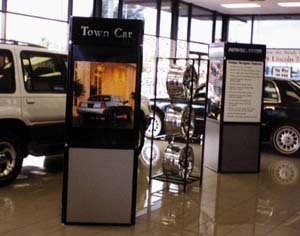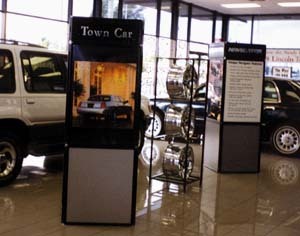Leno DeFeo says he happened upon the sign business "by accident." Four years ago, he quit the trucking industry and moved to Florida to start up a family business. When the business venture fell through, however, Leno and his wife Maria purchased the first business he came across in the classifieds: a failing Sign-a-Rama.
Although the couple may have entered the business "by accident," how they made the franchise work was anything but accidental. "[Sign-a-Rama’s corporate office] assured us that if we did ‘this,’ ‘this’ and ‘this,’ that ‘that’ would happen," says Leno. "I basically took their word for it and followed their program, and we evolved into the number 10 Sign-a-Rama location in the country."
One of the "this-es" that Sign-A-Rama recommended was a change in marketing. Specifically, the corporation suggested they adopt an aggressive marketing approach (making cold calls, following up leads, etc.). Another recommendation was for Leno to improve the store’s appearance. And the last bit of Sign-a-Rama advice: Offer a wide variety of products.
The previous franchise owner, says Leno, "was just selling vinyls, banners and PVC signs. We evolved into banners, neon, electric signs and tradeshow booths. If it has letters on it, we do it."
Electric signage
When Leno describes their product offerings as diverse, he’s not kidding — particularly because Sign-a-Rama franchises are often thought of as "vinyl-only" signshops. But their business is anything but.
Advertisement
Although they do create cut-vinyl letters and they have an Encad Novajet 3 printer, they don’t limit themselves to one-dimensional work.
"We started with some of the tradeshow items like headers that we did out of Lexan and acrylics, and then it just seemed to snowball for us," says Leno. "Every week we’re doing something different, for a different company, for a different tradeshow."
Sure, they still do standard cut-vinyl and printed vinyl jobs. (They created cut-vinyl-lettered banners for a tradeshow host that wanted one banner for each exhibiting company.) But Sign-a-Rama also creates some atypical tradeshow signage as well. Among their more unique show projects was a portable cabinet sign they made for a Hawaiian orchid company. The backlit sign, measuring 8-ft.-wide, 2-ft.-tall and 1-ft. deep, sat on an 8 and 1/2-ft.-high pedestal. It incorporated internal fluorescent lamping, a Lexan face, reverse-weeded vinyl, and a plug for use in the convention center’s standard electrical outlets. Interestingly, Leno and his staff were able to perform much of the work on this electric sign in-house. The aluminum frame was the only sign component they outsourced to another shop.
In addition to cabinet signs, Leno frequently fabricates portable neon signage for tradeshows. He admits that Sign-a-Rama staffers don’t bend the tubes in-house, but they do create the images and neon-bending patterns the benders use.
Booth building
Unlike many signshops, Leno never sells premade, stock booths. "Every booth that we’ve done, people have come in and picked our brains for input on what will and won’t work. . . . It’s always a challenge to try to come up with something different for each customer."
Advertisement
And the only "pre-fab" components he ever uses are Mark Bric-brand modular frames and panels. He says these work particularly well when they are internally lit with spotlights.
For most booths that he creates, Leno relies on his carpentry skills and makes booths using thin-gauge Lexan®. The most complicated project he ever designed incorporated aluminum as the primary fabrication material, however: It was a four-sided, 8-ft.-tall tower that could support a television set and a VCR.
When creating a booth, Leno feels the greatest challenge lies in aesthetics with practicality. "The booth needs to look nice. But it’s also got to be able to be broken down and shipped. You don’t want someone to spend an outrageous amount of money and then find out after one or two tradeshows that they’ve got to throw the booth in the garbage," he says.
To ensure he’s building a quality product, Leno visits tradeshows and checks out the booths that he’s fabricated in the past. He looks to see how the booths have held up and develops ways in which he can improve the durability of future projects.
Pricing
Leno admits it’s difficult to develop a pricing system for tradeshow booths because everything is custom-made. So, first he figures out the cost of the unit that he’s building and all the materials that are required. And he tries to keep close tabs on the time he spends on the project, which he says is usually "enormous."
Advertisement
Tradeshow booths, says Leno, are always expensive. "But we’ve been told that we have good pricing, based on what we do for a custom piece — only because so much goes into it. I keep evaluating what we do and what we’re spending. So over the years, we have increased our prices."
Summary
Leno says he loves doing the custom type of work required for tradeshows. And, with the seven employees in his shop, he has just the right mix of people to handle the demands of such work: "We have people who are mechanically inclined like myself. People who are artistically inclinded like my graphic artists, and we have really good installers. We can basically tackle anything."
Further, he recommends that other signshops not be afraid of big projects either: "If you shy away from a project you’ve never done, you’ll never learn anything. You’ve got to get your feet wet."
——————————————————————————–
Equipment & Materials
Leno DeFeo says his Sign-a-Rama is not a typical "vinyl signshop." He’s right. In his business, you’ll find some tools that may surprise you. These tools, however, are what enable him to perform electric sign work from which other vinyl shops might shy away. See for yourself:
vinyl cutters
digital-printing equipment (an Encad Novajet 3)
acrylic heat benders
tablesaws
razor cutters
a laminator
both IBM and Macintosh computers
an array of handtools


 Tip Sheet1 week ago
Tip Sheet1 week ago
 Ask Signs of the Times2 days ago
Ask Signs of the Times2 days ago
 Real Deal1 week ago
Real Deal1 week ago
 Benchmarks5 days ago
Benchmarks5 days ago
 Editor's Note2 weeks ago
Editor's Note2 weeks ago
 Women in Signs1 week ago
Women in Signs1 week ago
 Photo Gallery7 days ago
Photo Gallery7 days ago
 Product Buying + Technology2 weeks ago
Product Buying + Technology2 weeks ago


















